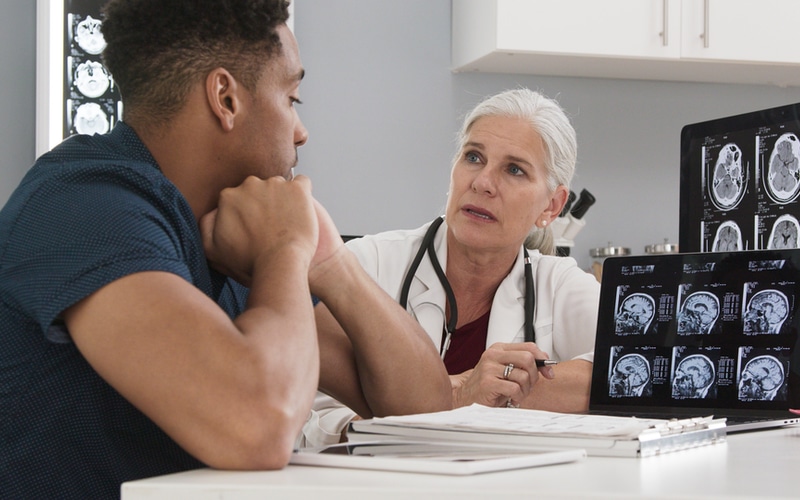When it comes to the shape of your spine, a slight degree of curvature is normal. When you look at your torso from the side, you should be able to see a gentle inward and outward curve from your neck to your lower back. When viewed from behind, however, the spine should appear as straight as a line.
For someone with adult Scoliosis, however, the spine looks more like a “S” or a “C,” rather than an “I,” which makes it look as if they’re leaning to the side. As you can expect, this improper imbalance can not only affect the appearance of the spine, but contribute to a great amount of pain and discomfort.
In this informative post, learn more about what adult Scoliosis is and when to see a Scoliosis specialist should you have it.
What is Adult Scoliosis?
Scoliosis is what happens when the curvature of the spine measures 10 degrees or more on an X-ray. Adult Scoliosis is the abnormal curvature of a fully-matured, adult spine, which, left untreated, can cause an altered gait, spinal instability and rigidity, and chronic pain.
Adult Scoliosis is most often caused when childhood Scoliosis is left untreated or is misdiagnosed, or when age-related changes or diseases affect the spine.
What Are The Symptoms of Adult Scoliosis?
Symptoms of adult Scoliosis can range from physical deformities to awkward movement to acute pain. Common physical symptoms include a “humpback” appearance, uneven shoulders, tilting of the trunk to one side, a poorly aligned head, or even abnormal prominence of the ribs. Mild to sharp pain is also common, as Scoliosis can compress the spinal nerve, resulting in lower limb weakness, numbness, or tingling. It can also greatly hinder coordination and balance, making it difficult to stand, walk, or even sit straight. Occasionally, compression of the lower spinal nerves can also make urination and defecation difficult, and in rare cases, even affect the lungs and heart.
How is Adult Scoliosis Diagnosed?
Generally, a comprehensive diagnosis by a spine specialist is needed to properly diagnose adult degenerative Scoliosis. During your consultation, they’ll review your medical history and family history, and perform both a neurological exam as well as a physical exam. Diagnostic imaging—such as X-ray, CT scans, or MRI scans—may also be used to improve the accuracy of the diagnosis.
To determine the proper treatment method, spine doctors use what’s called the Cobb Method, which measures the extent to which a curve has progressed. Generally, a curve that is greater than 25 to 30 degrees will require treatment of some kind, while curves that exceed 45 to 50 degrees are considered severe, and will often require more aggressive treatment.
How is Scoliosis Treated?
There are many different treatments for Scoliosis, many of which do not require surgery. Non-surgical treatments for Scoliosis include analgesics and anti-inflammatory medications, braces, spinal injections, and physical therapy. Lifestyle modifications—including dietary changes and regular exercise—can also help improve your pain management.
While most Scoliosis doctors view surgery as a last resort, it may be recommended if your spinal curvature progresses or is already greater than 45-degrees. In these cases, surgery may be encouraged to stop the curvature from getting worse, which could lead to life-threatening circumstances. Fortunately, Adult Scoliosis correction surgery, performed by an experienced surgeon, is a relatively safe procedure that often provides excellent results.
When Should I See A Scoliosis Specialist in Dallas TX?
Generally speaking, you should see a specialist for Adult Scoliosis in Dallas if your spinal curvature is causing any degree of pain or discomfort. After all, back pain of any kind should not be left untreated, as pain is a symptom that your body creates to warn you that something is wrong. What’s more, mild pain can often become debilitating pain, if left untreated.
You should also see a Scoliosis doctor if you experience shortness of breath, difficulty standing or sitting, or experience ongoing fatigue or tiredness. Scoliosis can affect your spine—and your health—in many ways, so it’s always best to see a specialist even if you have the slightest concern.
Want to work with the best Scoliosis doctors in Dallas? Schedule an appointment with one of our professionally trained spine specialists today! We’ll perform a thorough diagnosis of your condition and provide the advice, care, and treatment you need to experience lasting relief.


